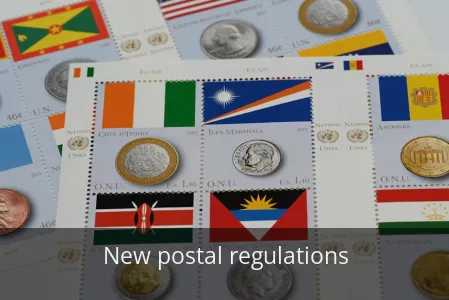
Have you ever waited weeks for a package that used to arrive in days, or been shocked by a new, mysterious “handling fee” at checkout?
You’re not alone, and the reason is a quiet revolution in how the world’s mail moves behind the scenes.
While the headlines focus on global trade wars and high-level negotiations, a slew of new regulations has completely reshaped your postal experience, and no one’s handing out a user manual.
Today, we’re pulling back the curtain on the seven biggest secrets that explain why your mail is slower and more expensive than ever before.
We’ll expose the real-world impacts on your wallet and your patience, and most importantly, give you the tools to fight back.
The Hidden Cost of “Fairness” in Global Shipping

It all started with a well-intentioned international agreement called the Universal Postal Union (UPU) treaty.
For decades, this system allowed small packages from countries like China to be shipped to the US at drastically reduced rates, a subsidy originally designed to help developing nations.
While great for consumers buying ultra-cheap goods, it put American small businesses at a massive competitive disadvantage.
In response, new regulations and tariffs were pushed through to level the playing field.
But as with many well-meaning policies, the unintended consequences for the average person have been staggering, and they’re not exactly being advertised on the front page of the news.
Why the silence?
Because announcing increased costs and delays isn’t exactly a great PR move for the powers that be.
The 7 Postal Secrets Impacting You Right Now

Let’s break down the specific changes hitting your mailbox and your bank account.
1. The Stealth Surcharge on Small Packages.
You’ve likely already encountered this one.
To counter those old subsidized rates, the U.S. negotiated the ability to set its own rates, known as “self-declared rates.”
The result?
The United States Postal Service (USPS) now charges foreign postal services more to deliver their packages here.
Those costs are inevitably passed down to the sellers, who then pass them directly to you in the form of higher product prices or new shipping surcharges.
2. The “Customs Clearance” Crawl.
With more packages now subject to higher scrutiny, the customs process has become a monumental bottleneck.
What was once a relatively smooth entry for low-value items now involves more paperwork, electronic data submissions, and inspections.
This doesn’t just add days; it can add weeks to your delivery time as packages sit in processing centers, waiting for the green light.
3. The Death of the Micro-Import.
Remember ordering a single, quirky phone case for $2 with free shipping?
Those days are largely gone.
The new cost structure makes it economically unviable to ship a single, tiny, low-cost item across the ocean.
Small businesses and hobbyists who relied on this model to offer unique products are being squeezed out, limiting your choices and driving you toward bigger, more generic retailers.
4. Opaque Tracking and Lost Package Limbo.
As foreign postal services grapple with the new complex US requirements, their tracking systems have failed to keep pace.
You might see a package leave its country of origin and then… nothing.
It enters a black hole of US processing, leaving you in the dark and making it incredibly difficult to file a claim if it gets lost.
The burden of proof, and the headache, falls squarely on you, the consumer.
5. The Small Business Squeeze Play.
American small businesses that export products are getting hit with a double whammy.
Other countries have responded to the US changes by raising their own rates for incoming American packages.
So, your favorite Etsy seller making handmade crafts now has to charge their international customers significantly more for shipping, making them less competitive in the global market and stifling their growth.
6. “Final Mile” Fee Frenzy.
This is a technical term for the last leg of delivery—when a package moves from a domestic distribution center to your door.
New regulations have increased the fees charged for this service.
For you, this means that even packages shipped from within the US might carry a slightly higher price tag to cover these behind-the-scenes cost increases that are invisible to the naked eye.
7. The Return-to-Sender Nightmare.
If a package doesn’t have the perfect, new, hyper-specific customs documentation, it won’t just be delayed.
It will be refused entry entirely and sent right back to the sender.
Navigating this process to get a refund is a labyrinthine task that many consumers simply give up on, effectively losing their money entirely.
Fighting Back: How to Navigate the New Postal Normal
All of this might feel overwhelming, but you are not powerless.
With a few smart strategies, you can protect yourself from the worst of these hidden impacts.
First, always read the shipping fine print before clicking “buy.”
Look for terms like “duties and taxes included” to avoid surprise fees upon delivery.
Second, consider the total cost, not just the product price.
A slightly more expensive item from a domestic seller might actually be cheaper and faster once you factor in reliable shipping.
Third, patronize small businesses that are transparent about these challenges.
They are battling this new landscape every day, and your support means more than ever.
Finally, arm yourself with knowledge.
Use updated shipping calculators and know that if a deal from an international seller seems too good to be true, it probably is—now more than ever.
The world of mail has changed forever, and the convenience we once took for granted is now a complex economic battlefield.
But by understanding the forces at play, you can become a savvier shopper, a more supportive consumer, and reclaim a bit of control over what arrives at your doorstep.
The question is, will you let these changes deliver frustration, or will you adapt and overcome?
From Regulatory Headache to Shipping Hero

So, how does a small business owner navigate this new maze of international shipping costs without losing their mind or their profit margins?
Meet Sarah, a ceramic artist whose whimsical mugs are now subject to bewildering new dimensional weight charges and cross-border tariffs.
Just last month, a surprise $40 customs fee for a customer in France nearly erased her profit on the entire order.
It was a stark lesson: guessing weight was a financial gamble she could no longer afford.
Enter her secret weapon: the Etekcity Digital Postal Scale.
This wasn’t just about replacing her old, unreliable kitchen scale; it was about reclaiming control.
Now, with a simple press of a button, she gets a precise, digital readout for every oddly-shaped package.
This little device provides the clarity she needs to accurately calculate those new, complex fees before she ever gets to the post office.
The relief is palpable—no more dreaded ‘balance due’ notifications or angry emails from customers facing unexpected delays at customs.
What used to be a point of intense stress is now a simple, 30-second task.
That reliable Digital Postal Scale transformed her shipping process from a regulatory nightmare into a streamlined, confident part of her daily routine.
It didn’t just save her money; it gave her peace of mind, turning a point of vulnerability into a pillar of her business’s foundation.

Leave a Reply